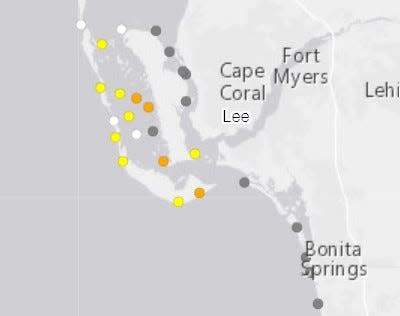Health officials lift swim advisory for toxic red tide on Bonita Beach, Fort Myers Beach
The Florida Department of Health in Lee County has lifted red tide-related health advisories for two popular location beaches: Lynn Hall Park on devastated Fort Myers Beach and the Bonita Beach public access areas.
Red tide (Karenia brevis) levels tested at both beaches recently.
The neurotoxin produced by red tide has been present in Lee County waters for several weeks now, and counts from the Tampa Bay areas south to Marco range from natural background concentrations to 1 million cell per liter and higher.
Although found naturally in the Gulf, red tide outbreaks are much worse today than they were decades ago as nutrients running off the landscape feed the deadly algae.

Fish kills can happen once levels reach 10,000 cells per liter, and much of Lee County waters in recent days have tested positive for the neurotoxin, according to the latest Florida Fish and Wildlife Conservation Commission.
Measurements in about half of Lee waters ranged from 10,000 to 100,000 cells per liter, according to FWC.
Lake O too high: Army Corps says Lake O too high, releases to Caloosahatchee to grow in wake of hurricanes
Warm weather: Hot days expected rest of the week, year as La Nina continues to influence patterns in SWFL
Bat habitat threatened: Advocates still concerned after FWS proposes more than 1 million acres of bonneted bat habitat
More: In region of natural beauty and harmful algae blooms, FGCU celebrates new water school
Blooms are more frequent, intense and longer-lasting than they were just 50 years ago, according to the University of Miami.
Background levels were also found at the remote Alison Hagerup Beach at the north end of Captiva and some local passes, which at times have tremendous currents and are not safe for swimming.
Connect with this reporter: @ChadEugene on Twitter.
This article originally appeared on Fort Myers News-Press: Algae outbreak that produces neurotoxins in Gulf waning in some areas
